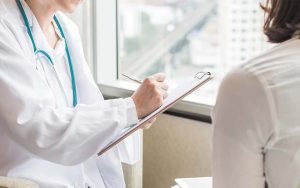Regular health care visits and screenings go a long way in preventing health issues, and are a must even for healthy individuals. Here is a list of important health screenings for women to help them be proactive about health.
Remember to consult a physician for specific personal guidance and suggestions on health screenings based on personal health history.
What Are Fibroids?
A fibroid is a non-cancerous (benign) growth of the womb (uterus). They are also called uterine myomas, fibromyomas or leiomyomas. Uterine fibroids are the most common pelvic growth among women. Their size can vary. Some are the same size as a pea and some can be as big as a melon. Fibroids can increase in size, decrease in size or even go away with time.
They can occur anywhere in the womb and are named according to where they grow:
- Intramural fibroids grow within the muscle tissue of the womb. This is the most common place for fibroids to form.
- Subserous fibroids grow from the outside wall of the womb into the pelvis.
- Submucous fibroids grow from the inner wall into the cavity of the womb.
- Pedunculated fibroids grow from the wall of the womb and are attached to it by a narrow stalk.

How Common Are Fibroids?
They are common. It is difficult to know exactly how common they are as many women won’t have any symptoms, and so may not know they have fibroids. It is estimated that between two and four in every ten women have, or will develop fibroids at some point in their lives. They usually develop in women aged 30-50 and can sometimes run in families. It is common to have several fibroids of various sizes, although some women just have one.
Fibroids Symptoms
Most women who have fibroids are not aware that they have them as they do not have any symptoms. Sometimes one is found during a routine examination by a doctor or by chance during a scan, which you may have for another reason. Symptoms may include:
- Heavy or more painful periods
Heavy and painful bleeding can be a sign of a range of conditions, and it is best to seek help early. Fibroids do not disturb the menstrual cycle but bleeding is often heavier than usual, sometimes with more pain. This can lead to low iron levels causing anemia (Low Haemoglobin levels). - Pain during sexual intercourse
If the fibroids grow near to the vagina or neck of the womb (cervix) then this can cause discomfort during sexual intercourse. - Problems during pregnancy
Having one or more fibroids does not cause any problems in the vast majority of women when they are pregnant. Occasionally, you may have pain or discomfort from your fibroid. This may be caused by the fibroid growing too large for its blood supply or twisting, if the fibroid has a stalk (also called pedunculated).
However, fibroids can be associated with an increased risk of having a caesarean section, the baby lying bottom-first rather than headfirst (breech) and early labour. Your doctor will advise you further if you are pregnant and have fibroids.
The Effects of Fibroids on Other Organs
Fibroids can have a chain reaction effect that includes:
- The rectum
A large enough fibroid can push down on the rectum, making bowel movements difficult. If the fibroid is on the underside of the uterus, you could have constipation or pain when defecating - The bladder
If the fibroid is on the other side of the uterus, growing toward your bladder, you might find you get up three or four times a night to go to the bathroom — you don’t have the capacity hold urine because of it. In addition to having to urinate more often, you might have difficulty or pain while urinating. - The stomach
Pelvic symptoms of fibroids include feeling like you have a full stomach. A fibroid can push up to your stomach creating “early satiety,”. You feel full faster and may not be able to eat as much as previously. If the fibroid grows big enough, your lower abdomen can look enlarged, as though you were pregnant. - The kidneys
In very rare instances, a fibroid can grow large enough to affect the ureter, the tube that connects the kidney and the bladder. If the flow of urine is backed up because o fibroid pressing on a ureter, the backpressure can cause the kidney to swell, a condition called hydronephrosis. Symptoms may include painful urination, a greater urge to go or going more often, an pain on one side. Kidney damage may result. In this case the only option is surgery to remove the fibroid.
How Are Fibroids Diagnosed?
Some fibroids can be felt during an internal (vaginal) examination by a doctor. Usually an ultrasound scan is done to confirm the diagnosis and to rule out other causes of any symptoms. Often, an ultrasound scan is enough, but sometimes a ‘Magnetic Resonance Imaging (MRI) scan is helpful as it provides a more detailed picture. If periods are heavy, a blood test would usually be done to check if you are anaemic.

Which treatment is right for me?
There are many treatments for fibroids, and it can be hard to decide which one is right. Treatment should based upon your fibroid-related symptoms.
Observation
If your fibroids are not causing any symptoms then treatment is not usually needed. Many women choose not to have treatment if they have symptoms that are not too bad. After the menopause, fibroids often shrink and symptoms tend to go or ease. You can change your mind and consider treatment if symptoms become worse. Your doctor may advise you to have a repeat scan to assess the growth and size of your fibroids.
Medical treatment for fibroid symptoms
Most medical treatments use a medicine to reduce the heavy menstrual bleeding, which is common in women with fibroids. A few medical treatments also shrink the fibroid too, and some are focused on reducing pain or correcting anemia. Medical treatments are often recommended before surgical treatments.
Iron and vitamins — For women who are anemic, the combination of iron supplements and a multivitamin, which will help the body effectively use the iron, is an effective option to combat anemia.
Nonsteroidal anti-inflammatory drugs (NSAIDs) — such as Mefenamic acid, ibuprofen and naproxen, can help reduce menstrual cramps and decrease menstrual flow in some women. You can take NSAIDs in combination with any of the medical treatments discussed here. However, NSAIDs do not reduce bleeding as well as most other medical treatments do.
Antifibrinolytic medicines — Antifibrinolytic medicines do not contain hormones and can help to slow menstrual bleeding quickly. These medicines work by helping blood to clot. Antifibrinolytic medicines do not shrink fibroids or correct anemia. Tranexamic acid is used worldwide and is also approved by the US Food and Drug Administration for the indication of heavy menstrual bleeding. The advantages of antifibrinolytic medicines over other medical treatments are that:
- The medicine slows bleeding quickly (within two to three hours)
- You need to take the medicine only during your period or only during the times when your period is heavy
- The medicines do not affect your chances of becoming pregnant
Hormonal birth control pills — Hormonal methods of birth control include the pill, skin patch, vaginal ring, shot, hormonal IUD, and implant. These treatments reduce bleeding, cramps, and pain during your menstrual period and can correct anemia. It might take three months for bleeding to improve after you start taking hormonal birth control.
Hormonal intrauterine device — intrauterine devices (IUDs) that slowly release a form of a progesterone-like hormone called a progestin into the uterus. This option is for women with fibroids that do not distort the inside of the uterus This IUD prevents pregnancy and reduces menstrual bleeding for up to five years.
Gonadotropin-releasing hormone agonists — Gonadotropin-releasing hormone (GnRH) agonists are a medicine given by injection once every one to three months that can be used to temporarily shrink uterine fibroids and temporarily stop menstrual bleeding. GnRH agonists work by “turning off” the ovaries, causing a temporary and reversible menopause. If you are scheduled to have your fibroids removed surgically, your doctor might recommend that you first use GnRH agonists for 3 to 6 months to shrink the fibroids, which can make them easier to remove. This treatment is not routinely recommended for longer than six months in a row due to the risk of thinning bones when used for long periods of time. GnRH agonists do not work immediately. They first cause an increase in ovarian hormones that can cause an increase in symptoms for the first few weeks. This “flare” can be a problem for women with heavy bleeding who are severely anemic. After a woman stops taking a GnRH agonist, her fibroids usually return to their previous size.

Surgical management of fibroids
Your doctor might recommend a surgical or interventional treatment for fibroids if:
- You have fibroid-related heavy menstrual bleeding, pain, or pressure that does not get better with medical treatments
- You are trying to get pregnant and fibroids appear to be interfering
- The size of the fibroid is giving you symptoms
There are a number of different surgical procedures that can be carried out to treat fibroids. Common surgical procedures that are used to treat fibroids include:
Myomectomy involves surgery to remove the fibroids from the wall of your womb. A myomectomy is an alternative to having a hysterectomy, particularly for women still wishing to have children. However, the procedure may not always be possible as it depends on your individual circumstances, such as the size, number and position of your fibroids. There are several ways to perform myomectomy; the “best” way depends on where your fibroids are located and the size and number of fibroids.
Abdominal myomectomy – This surgery requires an incision (cut) in the lower stomach to remove the fibroids.
Laparoscopic or robotic myomectomy – This surgery uses several small incisions in the stomach. A doctor uses thin instruments and a camera (laparoscope) to remove the fibroids. The fibroid then can be removed through a bigger incision or broken into smaller pieces for removal (morcellation). Robotic myomectomy is a variation of laparoscopic myomectomy where the surgical procedure is aided with a surgical robot.
Hysteroscopic myomectomy – If the fibroids are inside the uterus, a doctor can insert instruments through the cervix to remove the fibroids. This procedure helps more with heavy menstrual bleeding and not with size-related complaints.
Hysterectomy involves surgery to remove the womb. A hysterectomy is not usually necessary unless the fibroids are very large or you have severe bleeding. A hysterectomy may be advised in order to prevent fibroids recurring. Hysterectomy Can be performed Via several routes and techniques such as Abdominal , Laparoscopic or Robotic(Keyhole) or Vaginal route.
Endometrial ablation is removal of the womb lining. It is usually only carried out if your fibroids are near the inner surface of your womb. The affected womb lining is removed, which may be done in a number of ways, including using laser energy, a heated wire loop, microwave heating, or hot fluid in a balloon. Endometrial ablation can be used as an alternative to a hysterectomy.
Uterine artery embolisation (UAE) is a treatment option used to block the blood supply to fibroids. This is done by injecting a chemical through a small tube (catheter) that has been guided by X-ray scans into a blood vessel in your leg. This is usually used in women with large fibroids, and has been known to shrink fibroids by up to 60%. There are reservations about using this procedure in women who want to get pregnant.
Prevention
Although researchers continue to study the causes of fibroids, little scientific evidence is available on how to prevent them. Preventing uterine fibroids may not be possible, but only a small percentage of these tumors require treatment.
But by making healthy lifestyle choices, such as maintaining a normal weight and eating fruits and vegetables, you may be able to decrease your fibroid risk.
Dr. Vishal D. Jasani
Consultant Obstetrician and Gynaecologist, Pantai Hospital Klang


